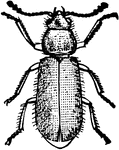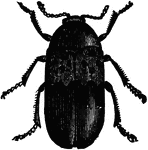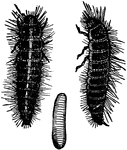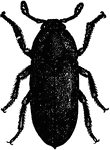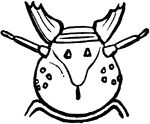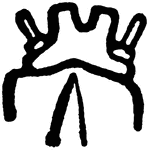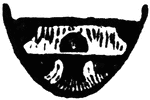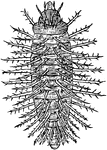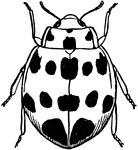
Goliathus Polyphemus
"This represents the Goliaths. These insects often feed upon matter in a state of putrefaction. They…

Gyrinus Distinctus
"A distinct species, which exists in a little lake of mineral waters in France, where visitors amuse…
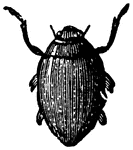
Gyrinus Natator
"They swim rapidly, describing incessantly capricious circles. These movements have gained for them…

Larva of Gyrinus Natator
"They swim rapidly, describing incessantly capricious circles. These movements have gained for them…
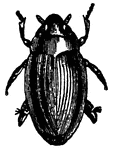
Gyrinus Striatus
"The Gyrinus Striatus is found in the waters of Southern Europe. These insects are all small,…

Harpalus Aeneus
"The innumerable tribe of Harpalidae (or Harpalinae) contains carnivorous beetles of very small size.…
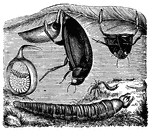
Hydrophilus Piceus
"It is common in fresh waters. It must not be seized without taking precautions, as its breast is provided…

Bristles at the Extremity of the Abdomen of the Hydrophilus Piceus
"The female is sometimes seen clinging to aquatic plants head downward, forming her cocoon, terminated…
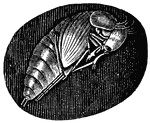
Pupa of the Hydrophilus Piceus
"At the end of two months the larva comes out of the water and burrows into the ground to undergo its…

Hylesinus Piniperda
"All vegetables, the vine, fruit trees, the ash, pine, etc., are eaten by some weevil or other."

Inca Clathrata
"They are met with in South America. The males have an extraordinary head. They fly during the day around…
!["The [potato beetle larva] is pale yellow, or, rather, dusky-yellow, or freckled with minute black dots on the back; and there are two rows of larger black dots along each side; the legs are black."—Nicholson, 1884](https://etc.usf.edu/clipart/79000/79099/79099_potatolarva_mth.gif)
Larva of Potato Beetle
"The [potato beetle larva] is pale yellow, or, rather, dusky-yellow, or freckled with minute black dots…

Megaceras Chorinaeus
"The Ateuchi are large, flat insects, with a broudtoothed clypeus. To this genus belongs the…

Larva of Mormolyce Phyllodes
"The innumerable tribe of Harpalidae (or Harpalinae) contains carnivorous beetles of very small size.…

Nebria Arenaria
"They are small almost globular, of a pale yellow with green lines, an live in sand bordering rivers.…
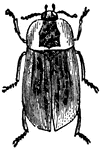
Necrodes Lacrymosa
"They introduce themselves under the skin of the carcasses of animals, and devour their flesh to the…
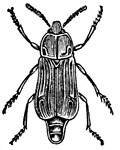
Necrodes Littoralis (Female)
"They introduce themselves under the skin of the carcasses of animals, and devour their flesh to the…

Necrophorus Germanicus
"The Necrophori, or Grave Diggers, are honest undertakers, who carefully bury carcasses left…

Necrophorus Vespillo
"The Necrophori, or Grave Diggers, are honest undertakers, who carefully bury carcasses left…
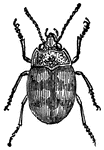
Omophron Libatum
"They are small almost globular, of a pale yellow with green lines, an live in sand bordering rivers."
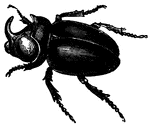
Oryctes Nasicornis (Male)
"A common specimen about an inch long, of a chestnut brown and perfectly smooth. The male, but not the…

Potato Beetle
Also known as Doryphora decemlineata. It is approximately 10 millimeters in length, with a bright yellow…

Rose Beetle (Cetonia Aurata)
"The rose-beetle frequents roses especially, of which it eats the petals and stamens. They fly by day…

Larva of Rose Beetle (Cetonia Aurata)
"It is found in rotten wood, and often in ants' nests. When it has acquired its full development, it…

Scarabaeus (Golofa) Porteri
"Some species collect portions of excrement, which they make up into balls and roll them until they…
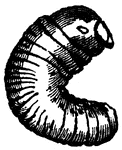
Larva of Scolytus
"Sometimes this larva destroys great forests of oak trees. In 1783, in the Forest of Hartz, 1,500,000…
!["They introduce themselves under the skin of the carcasses of animals, and devour their flesh to the bone. [This] species climbs trees and attacks caterpillars."](https://etc.usf.edu/clipart/53400/53416/53416_silpha_thora_mth.gif)
Silpha Thoracica
"They introduce themselves under the skin of the carcasses of animals, and devour their flesh to the…
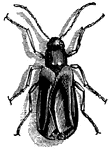
Sitaris Humeralis
"The female Sitaris Humeralis lays at the entrance of the nest of a solitary bee from 2,000…

First Larva of Sitaris Humeralis
"A month afterward there come out of these eggs very small larvae, of a shining dark green, hard-skinned,…

Pseudo Nymph of Sitaris Humeralis
"When the male bees have built the cells and furnished them with honey, the female, as we know, deposits…

Pupa of Sitaris Humeralis
The second larva stage lasts for 6 weeks. It contracts and passes through the winter. "In the spring…

Third Larva of Sitaris Humeralis
The second larva stage lasts for 6 weeks. It contracts and passes through the winter. "In the spring…


